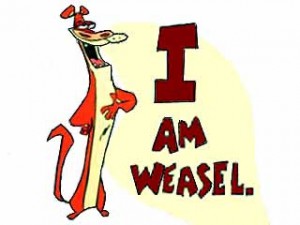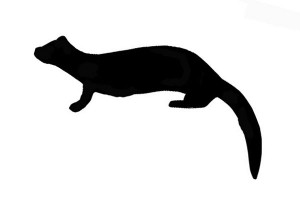Weasel.Eu
Domain For Sale –> de4dsn4ke@gmail.com
Domain For Sale –> de4dsn4ke@gmail.com

jún 28th
 Weasels (
Weasels (![]() /ˈwiːzəl/) are mammals forming the genus Mustela of the Mustelidae family. They are small, active predators, long and slender with short legs.
/ˈwiːzəl/) are mammals forming the genus Mustela of the Mustelidae family. They are small, active predators, long and slender with short legs.
Weasels vary in length from 12 to 45 centimetres (5 to 18 in), and usually have a red or brown upper coat and a white belly; some populations of some species moult to a wholly white coat in winter. They have long slender bodies, which enable them to follow their prey into burrows. Their tails may be from 22 to 33 centimetres (9 to 13 in) long. As is typical of small omnivores, weasels have a reputation for cleverness and guile.
Weasels feed on small mammals, and have from time to time been considered vermin since some species took poultry from farms, or rabbits from commercial warrens. Weasels occur all across the world except for Antarctica, Australia, and neighbouring islands.
The English word „weasel” was originally applied to one species of the genus, the European form of the Least Weasel (Mustela nivalis). This usage is retained in British English, where the name is also extended to cover several other small species of the genus. It is thought that the name „weasel” comes from the Anglo-Saxon root „weatsop” meaning „a vicious bloodthirsty animal”. However, in technical discourse and in American usage the term „weasel” can refer to any member of the genus, or to the genus as a whole. Of the 17 extant species currently classified in the genus Mustela, ten have „weasel” in their common name. Among those that do not are the stoat or ermine, the polecats, the ferret, and the European Mink (the superficially similar American Mink is now regarded as belonging in another genus, Neovison).
Collective nouns for a group of weasels include boogle, gang, pack, sneak and confusion.[1][2][3 
The following information is according to the Integrated Taxonomic Information System.
| Mustela africana | Desmarest, 1800 | Tropical weasel | South America |
| Mustela altaica | Pallas, 1811 | Mountain weasel | Europe & Northern Asia Southern Asia |
| Mustela erminea | Linnaeus, 1758 | Stoat Ermine Short-tailed weasel |
Europe & Northern Asia North America Southern Asia (non-native) New Zealand (non-native) |
| Mustela eversmannii | Lesson, 1827 | Steppe polecat | Europe & Northern Asia Southern Asia |
| Mustela felipei | Izor and de la Torre, 1978 | Colombian weasel | South America |
| Mustela frenata | Lichtenstein, 1831 | Long-tailed weasel | Middle America North America South America |
| Mustela itatsi | Temminck, 1844 | Japanese weasel | Japan & Sakhalin Is. (Russia) |
| Mustela kathiah | Hodgson, 1835 | Yellow-bellied weasel | Southern Asia |
| Mustela lutreola | (Linnaeus, 1761) | European mink | Europe & Northern Asia |
| Mustela lutreolina | Robinson and Thomas, 1917 | Indonesian mountain weasel | Southern Asia |
| Mustela nigripes | (Audubon and Bachman, 1851) | Black-footed ferret | North America |
| Mustela nivalis | Linnaeus, 1766 | Least weasel | Europe & Northern Asia North America Southern Asia (non-native) New Zealand (non-native) |
| Mustela nudipes | Desmarest, 1822 | Malayan weasel | Southern Asia |
| Mustela putorius | Linnaeus, 1758 | European Polecat Domesticated Ferret (ssp. furo) |
Europe & Northern Asia New Zealand (ssp. furo) (non-native) |
| Mustela sibirica | Pallas, 1773 | Siberian weasel | Europe & Northern Asia Southern Asia |
| Mustela strigidorsa | Gray, 1855 | Back-striped weasel | Southern Asia |
| Mustela subpalmata | Hemprich and Ehrenberg, 1833 | Egyptian weasel | Egypt |
1 Europe & Northern Asia division excludes China.
The extinct „Sea mink” was commonly included in this genus as Mustela macrodon, but in 1999 was moved to the genus Neovison.[
Source : www,wikipedia.org